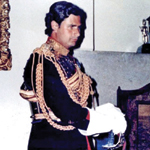|
Major H St J Holcroft
Late The Blues and Royals
by Major P A J Wright OBE
formerly Grenadier Guards

|
Harry St John Holcroft was born in Birmingham in 1951 and educated at Downside where the art teacher, a one-armed monk, encouraged his artistic talent. He read development economics at Hertford College, Oxford, and studied art at Ruskin School of Drawing. Born on 2nd May 1951, he died after a fall on 3rd November 2013, aged 62 when painting in India. Harry was a soldier, adventurer and writer who painted the world’s rainforests and trade routes, but will be known in the Household Cavalry as a man of charm and wit who was more at home with a paintbrush and a drink in his hand than being in a turret with a pressel switch. He served for 23 years in The Blues and Royals, serving at Windsor, Hyde Park Barracks and Detmold, Germany, with tours of Cyprus, Northern Ireland and Germany, before being invalided out with osteoporosis. Laissez-faire by nature, he was a problem solver with a flexible approach. While being positively horizontal on the laid back scale he was able, sympathetic and widely talented. While never much enjoying riding, with regular falls at Summer Camp, he enjoyed being in London in the ‘70s as this gave him plenty of opportunities to paint, his penchant at the time being cartoonish animals in human activities.
On leaving the Army he chose to paint full-time. A widely travelled artist, he was as much at home in the insect-infested jungle as he was in the rolling countryside of Provence where he lived. He painted the botanical and animal life of the world’s great tropical rainforests of Central and South America, Africa, India and Southern Asia. His pictures sold well. During the 1970s he received commercial commissions for companies as diverse as Drambuie, Bear Stearns, BP Oil and The Economist, and in the 1980s he painted many watercolours of the Middle East.
Above all, it was for his intrepid jungle expeditions and paintings of desolate rainforests that he is best known. His adventures were all the more impressive because from an early age he had suffered from osteoporosis, the degenerative bone disease. During his life he had four hip replacements. Although a family man he was a free spirit, with a solitary streak. He loved travelling and painting the world. He would take with him little more than his ‘toybox’, a blue briefcase, containing sketchbooks, watercolours, pencils and the silk cocoon in which he slept.
During his travels in the rainforest he often snacked on local delicacies such as red ants. In one Brazilian tribe the children fill the hollow centres of palm stalks with palm oil and leave them out overnight to attract ants. Next morning when the stalks have turned pink with the ants, they pick them off and enjoy them like popcorn. Harry joined them and found the ants peppery. He was a thoughtful, kind and courteous man and made friends easily.
Good-looking and stylishly scruffy, Harry charmed everyone he met. He painted the rainforest because he was haunted by its devastation and attracted to its subtle changing light, vivid colour, feeling of space and primeval chaos. As an artist, he felt challenged by the impenetrable jungle landscape that offered no perspective or horizon. Over the course of his travels, he witnessed the dwindling of the forests of Central and South America and Borneo owing to deforestation. He made five trips to the Amazon. His paintings drew attention to the plight of the world’s forests and his work was shown in the West End, New York, Los Angeles and Provence. He was also comfortable in the searing heat of India. His parents had married in Assam, where his mother’s family had been tea planters and colonial administrators. He had spent the past two winters as artist-in-residence of Ahilya Fort, Maheshwar, central India, the family seat of his friend Prince Richard Holkar. Harry had spent much time drawing and painting the Narmada river and helped in teaching art to children at the local school.
Harry was also an accomplished writer. He was particularly inspired by the example of Colonel Frederick Gustavus Burnaby, the ‘True Blue’ and his 19th-century exploits. Burnaby had explored Asia Minor and beyond and Harry, following in his hero’s footsteps, travelled across Europe to China to trace the 15th-century Silk Route, keeping an illustrated diary along the way. This journey, in three trips, took him three years. His illustrations accompanied by his lively text were published in The Silk Route in 1999. His other published works include: The Spice Route (2000), The Slave Route (2003) and Rainforest: Light and Spirit, a collaboration with the botanist and ecologist Professor Sir Ghillean Prance (2009). The Prince of Wales, who wrote the foreword, referred to it as a ‘call to arms’. Carrying little more than his briefcase, Harry travelled across desert, mountain, oceans and jungle, while researching his books. He was writing a book on the South Seas and the Pacific when he died suddenly in India after falling down a flight of steps.
Harry was first married to Joanna Clifton-Brown, with whom he had two daughters, Olivia and Samantha. Secondly, he married Sarah Jane Brooks, the daughter of Christopher Brooks and Patricia Matthews, the late Viscountess Rothermere, in 1988. She survives him with their two sons, Christopher and Harry.
With thanks to The Times.
|
|

